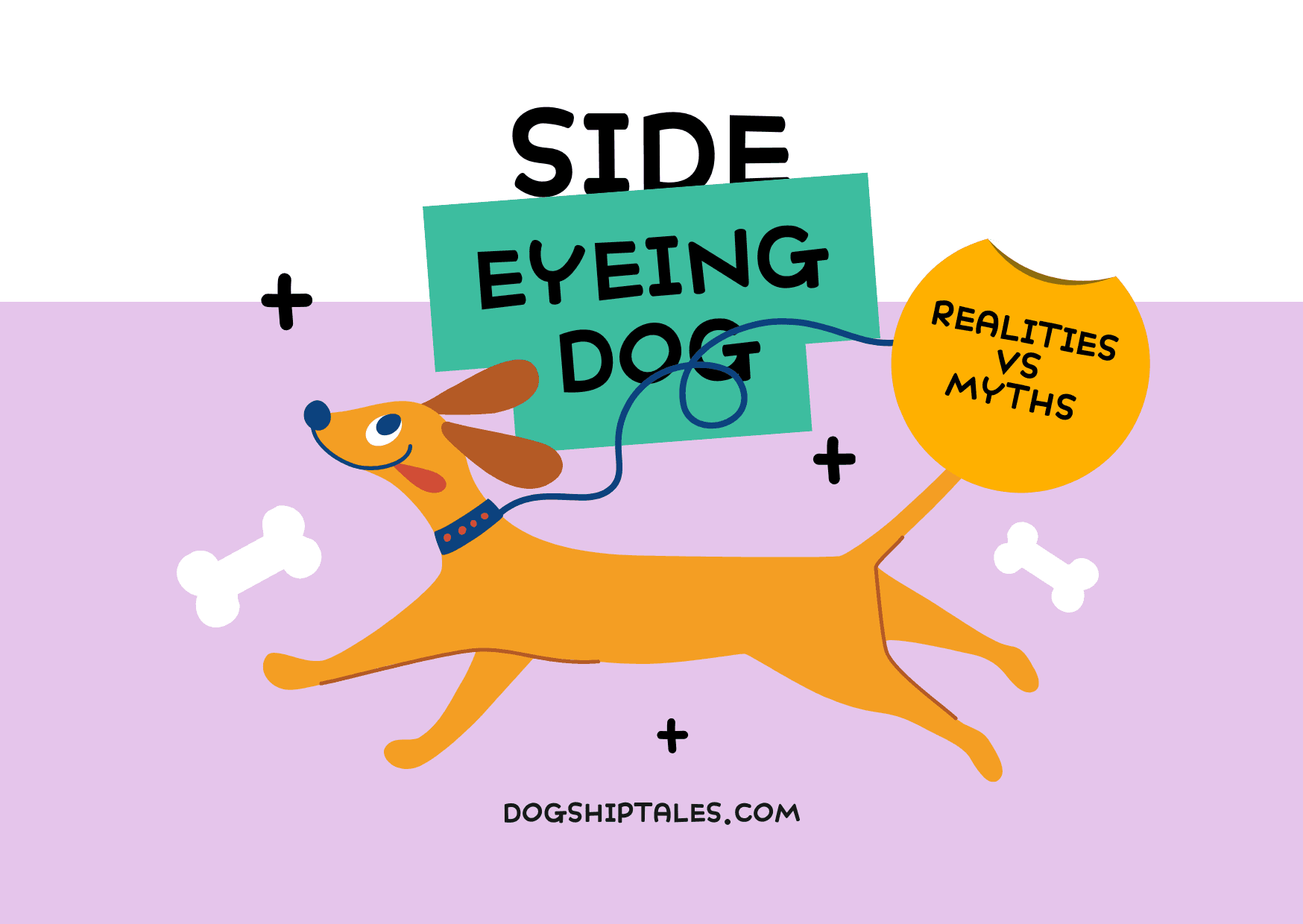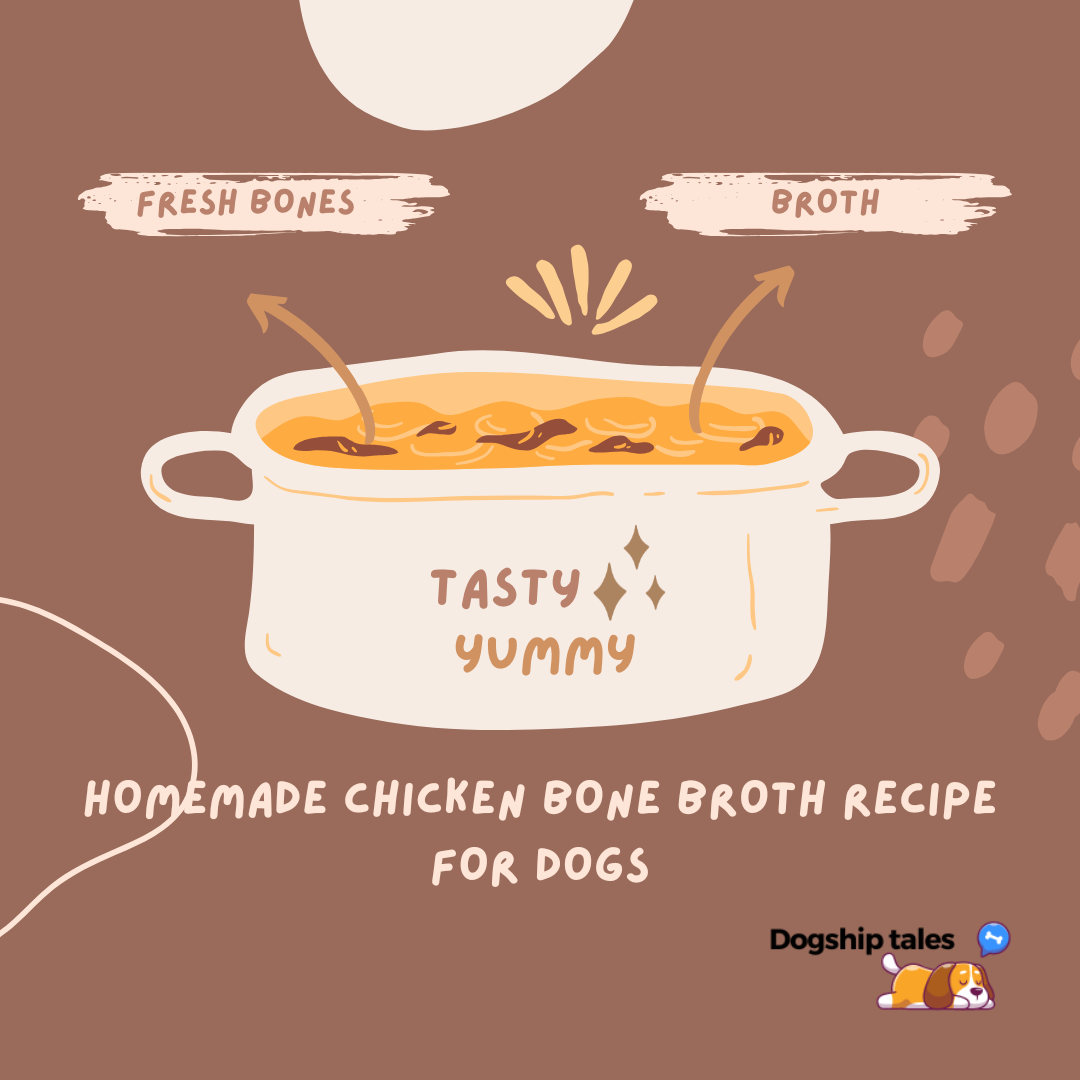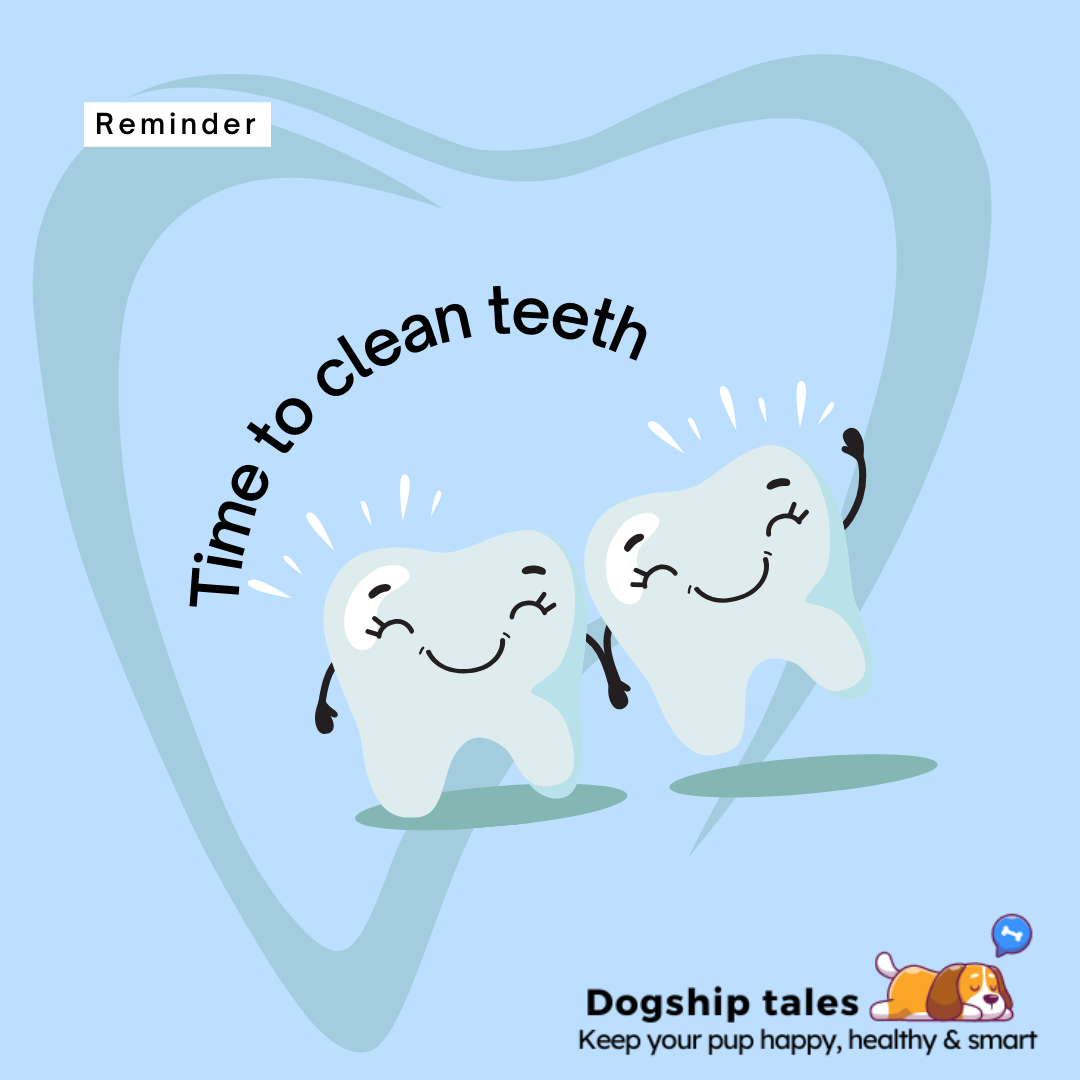Introduction
Dog side eye me, why? Why my dog is side eyeing? Is side eyeing dog normal? Side eye dog is indicating some serious threats around? “Dogs express their anger by Side eyeing.” If you see a Side eyeing dog around, run, he is intended to harm you.”
There is a long long list of myths circulating regarding side eyeing dogs and almost 90% of them are just the misconceptions. It is just a normal behavior of dogs and nothing else. They just keep an eye on everybody around and side eye them keenly.
As you know that dogs have a special trait of sensing intentions of strangers around so they are always been on an alert mode. This alert mode sometimes make them side eyeing on people around.
1. What is the Dog Side Eye?
Dog side eye is actually a dog’s gesture when he seems looking to its extreme sides, exposing white part of his eyes. It more looks like Whale eye, half-moon eye also referred as canine side glance.
You will experience side eyeing dog more when you go to their rest area. When they calmly lay down to rest and somebody pass-by, they will look at him side eyeing. Its kind a gesture not a threat actually.
2. Myths Surrounding Side Eye dogs
Myth 1.Dog Side Eye Means Aggression
Reality: Side eye doesn’t necessarily indicate aggression. It’s often a signal that a dog feels uncomfortable and is setting boundaries rather than preparing to attack. Dogs communicate primarily through body language, and side eye is just one small piece of the puzzle. In isolation, side eye alone isn’t a definitive sign of aggression but a request for space.
Myth 2. Side Eye is Always a Sign of Fear or Distrust
Reality: While fear can sometimes lead to side eye, it isn’t always the case. Dogs give side eye in various situations, including playful or curious moments, without necessarily being scared. In fact, during playful activities, a relaxed dog might give a quick side glance as a way of showing engagement.
When fear is involved, side eye might be accompanied by a tucked tail, lowered head, or flattened ears, and they may appear to be retreating or avoiding direct contact.
Myth 3. Side Eye Means My Dog is Feeling Guilty
Reality: Many dog owners attribute side eye to guilt, especially if the dog’s done something wrong, like chewing a shoe or knocking over the trash. However, studies on dog behavior reveal that “guilt” as humans experience it doesn’t quite apply to dogs. Instead, side eye in this scenario often comes from a response to your reaction rather than guilt. They might sense your tone, body language, or facial expression and respond accordingly, trying to defuse tension with a submissive or cautious look.
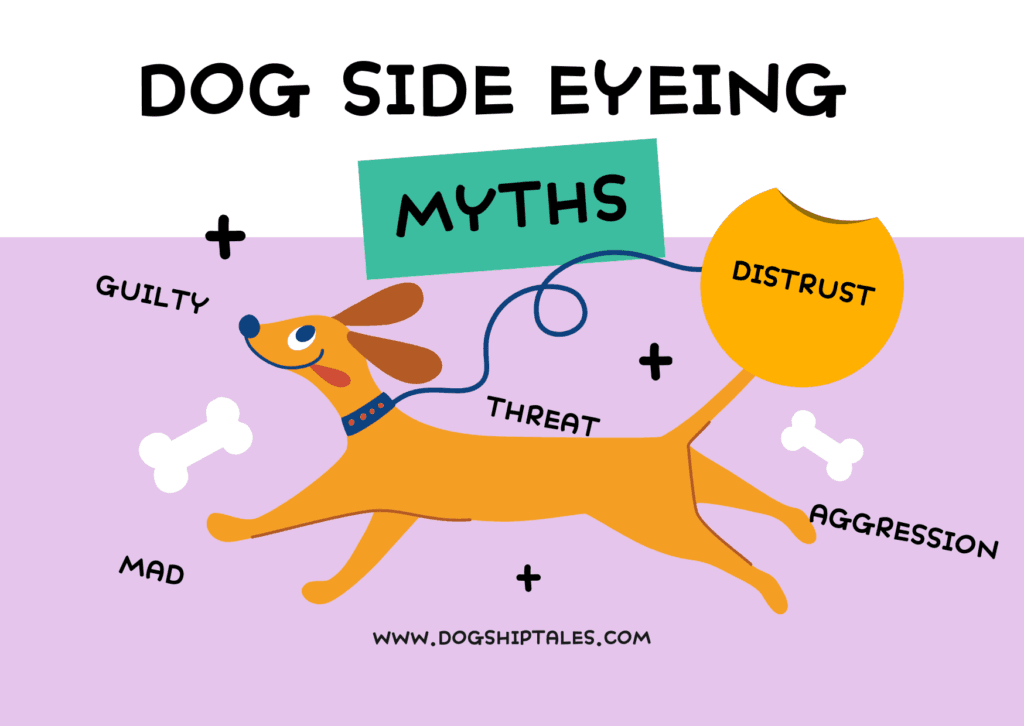
3. The Reality Behind Dog Side Eye
Dog behaviorists and veterinary studies shows that every emotion of dogs is linked to their body language. They are treated and trained by their parents in a different way so they shows unique body language to tell you their need or feel towards something.
In order to understand your pup’s signal you should pair Side eye with other behaviors (e.g., body posture, tail position). It will help you better get their need.
Look for signs of stress, discomfort, excitement, fear or playfulness that may give you more idea to understand what they shows by side eyeing you.

4. Situations When Dogs Give Side Eye and What They Mean
Living with dogs is such a learning and fun experience for me. I always see new expressions and enjoy new emotions that my furry friend shows towards different things. In different dogs I noticed different signals that they shows by side eyeing, let me list some here,
- Protective or Territorial Behavior
- Mostly, when dogs are guarding food, toys, or space, they may show side eye to indicate boundaries. This is a common behavior of dogs as they show possessive behavior towards their parents and toys.
- Playful Side Eye
- In play, side eye can be paired with relaxed body language, showing it’s a playful and non-threatening expression. People mostly connect side eye dog memes with this gesture of their pups. Every dog is lovely and show cute expressions like these.
- Discomfort and Warning Signs
- In some cases, Dog side eye is a precursor to defensive actions (e.g., growling, body tension). It sometimes collectively evoke an aggressive or threatening behavior towards strangers.
5. How to Respond to Dog Side Eye
- Read the Full Body Language: When you notice side eye, look at the whole picture. Ears pinned back, a tucked tail, or raised hackles alongside side eye often suggest discomfort or distress, while relaxed postures and open expressions indicate neutrality or playfulness.
- Give Space: If your dog is showing side eye in a defensive manner (e.g., guarding their food or toy), it’s best to respect their space and allow them to relax.
- Reassure or Redirect: In anxious situations, providing reassurance or redirecting your dog’s attention can help them feel more secure. Gentle petting or engaging in a known command, like “sit,” can provide focus and reduce discomfort.
- Use Positive Reinforcement: If side eye is stemming from nervousness, try to create positive associations. For instance, if a dog often shows side eye in a specific situation, rewarding calm behavior with a bowl of treat can help build confidence over time.
6. Training Tips to Address Side Eye in Context
- Teach Boundaries: If your dog tends to guard resources with side eye, practice boundary exercises using commands like “leave it” or “stay.”
- Increase Socialization: Gradually introduce new environments, sounds, or people can help dogs grow more comfortable in diverse situations, reducing anxiety-based side eye.
- Work on Confidence-Building Activities: For dogs who seem fearful, confidence-building exercises (like agility or obedience training) can improve their self-assurance, leading to more relaxed behavior.
Conclusion
The “side eye” is one of the many subtle ways that dogs communicate their feelings, boundaries, and needs. While it’s commonly misinterpreted as a sign of aggression or guilt, it’s usually just a reflection of discomfort or curiosity. By understanding and respecting this expression, we can better support our dogs’ emotional well-being, strengthening the bond between us.
So next time your dog gives you that sideways glance, you’ll know they’re simply telling you what they need in their own unique way.
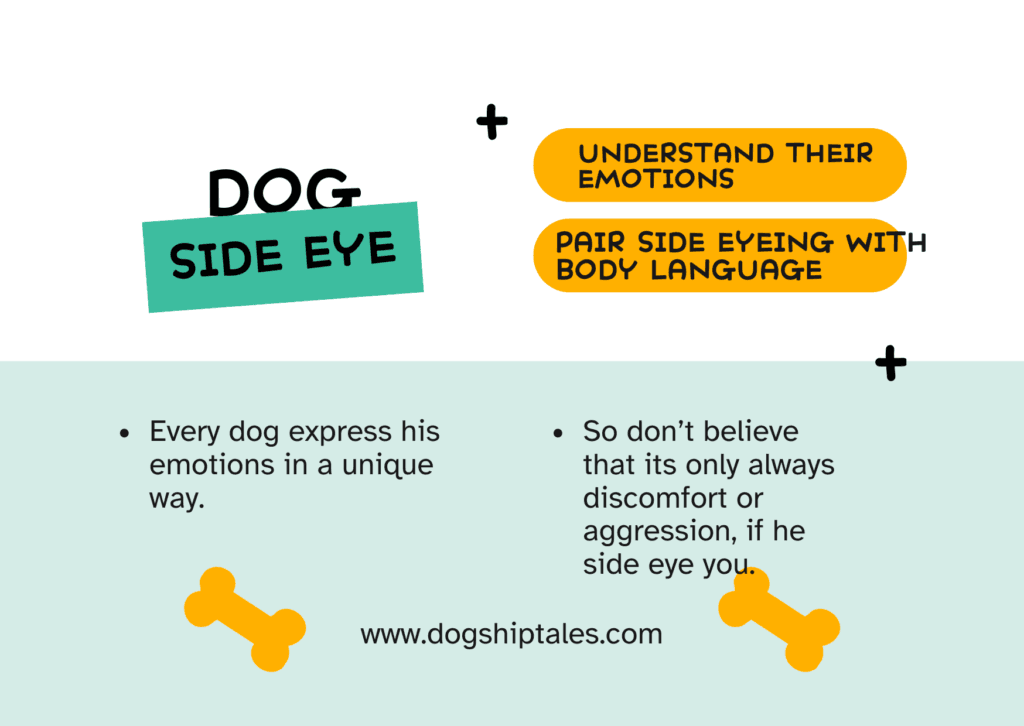
Frequently Asked Questions
1. What does it mean when my dog gives me a side-eye?
The side-eye, often referred to as “whale eye,” is when a dog turns its head away but keeps its eyes fixed on something or someone, showing the whites of their eyes. This can signal discomfort, stress, or heightened alertness or playfulness depending on their training.
2. Is side-eye in dogs a sign of aggression?
Not always. While a tense side-eye accompanied by stiff body posture and other stress signals (e.g., pinned-back ears or lip licking) might indicate a warning, a relaxed side-eye could simply reflect curiosity or playfulness.
3. How can I differentiate between playful and stressed side-eye?
Context and accompanying body language are key. Playful side-eye is often paired with wagging tails and relaxed postures, while stressed side-eye may involve avoidance behaviors or signs of anxiety like yawning or tense muscles.
4. Do certain breeds show side-eye more frequently?
Yes, breeds with prominent or wide-set eyes, such as Boston Terriers and Pugs, might naturally display more side-eye due to their facial structure. Meanwhile, breeds with strong guarding instincts, like German Shepherds, may use side-eye more as a warning in specific scenarios.
5. How should I respond to my dog’s side-eye?
If it indicates discomfort or stress, assess the environment and try to remove triggers. Provide space, avoid direct eye contact, and use positive reinforcement to create a safe and reassuring atmosphere. For persistent or intense displays of side-eye linked to stress, consulting a professional trainer or behaviorist is recommended.

